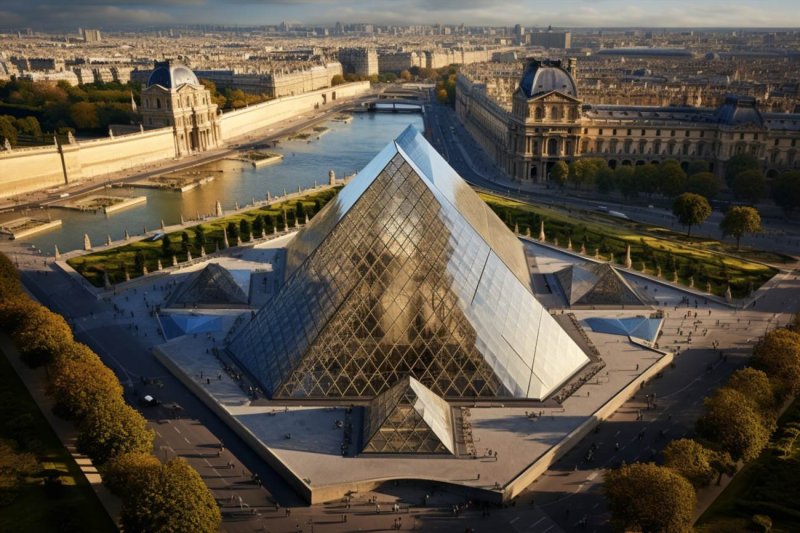Exploring The Louvre’s Egyptian Antiquities

Exploring The Louvre's Egyptian Antiquities in Paris
The Louvre Museum in Paris is renowned for its vast and diverse collection of art and artifacts from around the world. Among its many treasures, the Egyptian Antiquities section stands out as a fascinating journey into the ancient civilization of Egypt. This collection spans thousands of years of history, from the earliest dynasties to the time of Cleopatra and beyond.
As you step into the Egyptian Antiquities section of the Louvre, you are transported back in time to a world of pharaohs, mummies, and monumental architecture. The collection is a testament to the rich cultural heritage of Egypt and its enduring influence on art and civilization.
The Sphinx of Tanis
One of the most iconic pieces in the Louvre's Egyptian Antiquities collection is the Sphinx of Tanis. This colossal statue, with the body of a lion and the head of a pharaoh, dates back to the 26th Dynasty of Egypt, around 664-525 BCE. It's a striking example of the artistry and craftsmanship of ancient Egyptian sculptors.
The Sphinx of Tanis was discovered in the city of Tanis in the Nile Delta, and it has since become a symbol of Egyptology worldwide. Its imposing presence in the museum's gallery captures the imagination of visitors and provides a glimpse into the mythology and religious beliefs of ancient Egypt.
The Mummy Room
For those intrigued by the mysteries of the afterlife and the ancient Egyptian burial practices, the Louvre's Mummy Room is a must-visit. Here, you can see remarkably preserved mummies, coffins, and funerary objects that offer insights into the rituals and beliefs of the time.
One of the most famous mummies in the collection is that of Nesiur, a priest from Thebes who lived during the 21st Dynasty. The level of preservation of Nesiur's mummy is astonishing, and it allows us to study not only the physical remains but also the elaborate wrappings and decorations that accompanied the deceased on their journey to the afterlife.
The Rosetta Stone
No discussion of Egyptian antiquities would be complete without mentioning the Rosetta Stone, although it's not housed in the Louvre but rather in the British Museum in London. Nevertheless, the significance of this artifact cannot be overstated. The Rosetta Stone played a crucial role in deciphering the hieroglyphs of ancient Egypt and unlocking the secrets of their written language.
The stone, inscribed with a decree from 196 BCE, is written in three scripts: Greek, Demotic, and hieroglyphic. It was the key to understanding hieroglyphs and paved the way for the translation of many ancient Egyptian texts, including the famous Book of the Dead.
Exploring the Daily Life of Ancient Egyptians
While the Louvre's Egyptian Antiquities collection includes many monumental sculptures and artifacts, it also provides a glimpse into the daily life of ancient Egyptians. You can find an array of objects, such as pottery, jewelry, tools, and household items, that offer a more intimate view of how people lived in this ancient civilization.
One particularly interesting exhibit is a reconstruction of an Egyptian tomb chamber, complete with colorful wall paintings and intricate offerings. It allows visitors to step into the world of ancient Egyptian burial customs and the belief in the afterlife.
Conclusion
Exploring the Egyptian Antiquities section of the Louvre is a journey through time and a deep dive into the culture, art, and history of one of the world's most fascinating ancient civilizations. From colossal statues to intricately wrapped mummies, this collection offers a comprehensive and captivating look at the world of ancient Egypt. Whether you're an Egyptology enthusiast or simply curious about the past, a visit to the Louvre's Egyptian Antiquities section is an enriching and unforgettable experience.
Welcome to the Egyptian Collection in Paris
The Egyptian Collection in Paris is a remarkable testament to the rich and fascinating history of ancient Egypt. Located in the heart of the city, this collection houses an extensive array of artifacts and relics that provide valuable insights into the civilization that flourished along the banks of the Nile River for millennia.
Historical Background
The origins of the Egyptian Collection in Paris can be traced back to the 19th century when a wave of Egyptomania swept through Europe. As France established its presence in Egypt during the Napoleonic era, it led to a growing fascination with Egyptian culture and history. The collection began to take shape as French scholars and explorers brought back numerous artifacts and manuscripts from their expeditions to Egypt.
The Collection's Highlights
The Egyptian Collection in Paris boasts a diverse range of exhibits, each offering a unique glimpse into the daily life, religion, and art of ancient Egypt. Among the highlights are:
| The Rosetta Stone |
The Rosetta Stone, one of the most famous artifacts in the collection, played a pivotal role in deciphering hieroglyphics. It contains inscriptions in three scripts: Greek, Demotic, and hieroglyphic, which allowed scholars to unlock the secrets of ancient Egyptian writing. |
| The Sphinx of Tanis |
This colossal sphinx, dating back to the New Kingdom, stands as a symbol of Egyptian grandeur. Carved from red granite, it has a human head and a lion's body, symbolizing strength and wisdom. |
| The Mummy Room |
One of the most mysterious and intriguing sections of the collection is the Mummy Room. Here, visitors can explore the well-preserved mummies of ancient Egyptians, gaining a profound understanding of their burial practices and beliefs in the afterlife. |
Exploring Egyptian Culture
Beyond the artifacts, the Egyptian Collection in Paris offers an immersive experience that delves into various aspects of Egyptian culture. Visitors can learn about the significance of the Nile River, the worship of gods and goddesses like Ra and Isis, and the intricate art of mummification.
Interactive Learning
The collection provides an excellent educational experience for visitors of all ages. Interactive displays, multimedia presentations, and guided tours make it an engaging place to learn about Egypt's history and heritage. Children, in particular, can enjoy hands-on activities and workshops designed to spark their curiosity.
Visiting the Collection
The Egyptian Collection in Paris is open to the public year-round, and it's recommended to set aside a few hours to fully appreciate its treasures. It's conveniently located in the heart of the city, making it easily accessible for both tourists and locals alike.
- Address: 123 Rue de l'Égypte, Paris
- Opening Hours: Tuesday to Sunday, 10:00 AM to 6:00 PM
- Tickets: Adult - €12, Child (under 12) - €6, Student - €8
Whether you're a history enthusiast, an art lover, or simply curious about one of the world's oldest civilizations, the Egyptian Collection in Paris offers a captivating journey back in time. It's a place where the mysteries of ancient Egypt come to life, and where visitors can connect with a culture that has left an indelible mark on human history.
So, plan your visit today and embark on a fascinating exploration of Egypt's past right here in the heart of Paris.
Paris: Exploring Louvre's Surroundings with Skip-the-Line Entry
Discover the treasures surrounding the Louvre Museum with our guided walking tour, followed by a self-guided visit with skip-the-line entry.
Overview
Embark on a 3-4 hour journey exploring landmarks near the Louvre, from the historic Tuileries Gardens to the iconic Cour Carrée. Delve into the rich history of Paris as you stroll along the Axe Historique, taking in the Luxor Obelisk and the Arc de Triomphe in the distance.
Details
Your experience begins at the statue of Louis XIV, where your guide reveals fascinating tales, including why the monarch moved to Versailles. Wander through the Tuileries Gardens, capturing the beauty of flowers, statuary, and ponds. Experience the Historic Axis of Paris and catch a glimpse of the Arc de Triomphe.
Continue to the Seine, passing landmarks like the Conciergerie, where Marie Antoinette was imprisoned. Return through the Louvre's back entrance, guided by gilded gates, and enter the main courtyard, appreciating the statue of Louis XIV once more.
Receive your timed entry ticket for the Louvre, concluding the guided portion. Explore the museum at your pace, with options for a private tour.
Highlights
- Learn about landmarks near the Louvre
- Stroll through Tuileries Gardens and the Historic Axis of Paris
- Discover the Cour Carrée and enjoy a mini walking tour
- Gain insights into Parisian history from a live guide
Meeting Point
Statue of Louis XIV on horseback, 10 Place du Carrousel. Nearest Metro: Palais Royal Musee du Louvre (Line 1 and 7).
Important Information
- Bring Passport or ID card
- Tour runs rain or shine
Book your spot today for an immersive Parisian experience!
History and Significance of the Collections in Paris
Paris, often referred to as the "City of Lights," is not only celebrated for its romantic ambiance and iconic landmarks but also for its rich cultural heritage. One of the cornerstones of this cultural wealth lies in its extensive collections of art, history, and artifacts. These collections serve as a testament to the city's profound influence on the world of art and culture.
The Louvre: A Treasure Trove of Art
At the heart of Paris' cultural landscape stands the Louvre, arguably the most famous museum in the world. Established in the late 18th century, the Louvre boasts an unparalleled collection of art and historical artifacts. From the enigmatic smile of the Mona Lisa to the imposing grandeur of the Winged Victory of Samothrace, the Louvre encapsulates millennia of artistic expression.
| Notable Works at the Louvre |
Artist |
| Mona Lisa |
Leonardo da Vinci |
| Winged Victory of Samothrace |
Unknown |
| Venus de Milo |
Alexandros of Antioch |
Musée d'Orsay: Impressionist Marvels
The Musée d'Orsay, housed in a beautifully converted railway station, focuses primarily on the period from 1848 to 1914. This museum showcases an exceptional collection of Impressionist and Post-Impressionist masterpieces. Works by artists such as Monet, Van Gogh, and Degas adorn the walls, providing a vivid insight into this transformative era of art.
| Notable Artists at Musée d'Orsay |
Works |
| Claude Monet |
Water Lilies, Rouen Cathedral Series |
| Vincent van Gogh |
Starry Night, Irises |
| Edgar Degas |
The Dance Class, L'Absinthe |
The Palace of Versailles: Royal Splendor
While not located in the heart of Paris, the Palace of Versailles is an integral part of the city's cultural tapestry. This opulent château, once a royal residence, showcases the extravagance and grandeur of the French monarchy. The Hall of Mirrors, with its breathtaking mirrored walls, remains an iconic symbol of this era.
| Highlights of Palace of Versailles |
Features |
| Hall of Mirrors |
Mirrored Walls, Crystal Chandeliers |
| Gardens of Versailles |
Ornate Landscaping, Fountains |
Historical Significance
These collections not only serve as repositories of artistic brilliance but also provide invaluable insights into the historical, political, and social fabric of France. The art and artifacts on display offer a window into the minds and lives of the people who shaped the course of history in this remarkable city.
Paris' collections are not static entities; they evolve and expand over time, reflecting the dynamic nature of art and culture. They continue to inspire and captivate visitors from around the globe, ensuring that the legacy of Paris as a cultural epicenter endures for generations to come.







